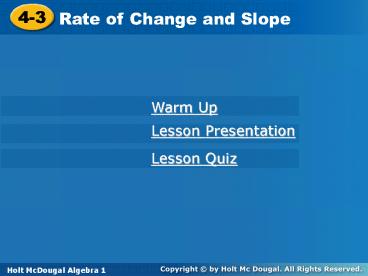Rate of Change and Slope - PowerPoint PPT Presentation
1 / 25
Title:
Rate of Change and Slope
Description:
4-3 Rate of Change and Slope Warm Up Lesson Presentation Lesson Quiz Holt Algebra 1 Holt McDougal Algebra 1 Warm Up 1. Find the x- and y-intercepts of 2x 5y = 20. – PowerPoint PPT presentation
Number of Views:232
Avg rating:3.0/5.0
Title: Rate of Change and Slope
1
4-3
Rate of Change and Slope
Warm Up
Lesson Presentation
Lesson Quiz
Holt Algebra 1
Holt McDougal Algebra 1
2
Warm Up 1. Find the x- and y-intercepts of 2x
5y 20. Describe the correlation shown by the
scatter plot. 2.
x-int. 10 y-int. 4
negative
3
Objectives
Find rates of change and slopes. Relate a
constant rate of change to the slope of a line.
4
Vocabulary
rate of change rise run slope
5
A rate of change is a ratio that compares the
amount of change in a dependent variable to the
amount of change in an independent variable.
6
Example 1 Application
The table shows the average temperature (F) for
five months in a certain city. Find the rate of
change for each time period. During which time
period did the temperature increase at the
fastest rate?
Step 1 Identify the dependent and independent
variables.
dependent temperature independent month
7
Example 1 Continued
Step 2 Find the rates of change.
The temperature increased at the greatest rate
from month 5 to month 7.
8
Check It Out! Example 1
The table shows the balance of a bank account on
different days of the month. Find the rate of
change during each time interval. During which
time interval did the balance decrease at the
greatest rate?
Step 1 Identify the dependent and independent
variables.
dependent balance
independent day
9
Check It Out! Example 1 Continued
Step 2 Find the rates of change.
The balance declined at the greatest rate from
day 1 to day 6.
10
Example 2 Finding Rates of Change from a Graph
Graph the data from Example 1 and show the rates
of change.
Graph the ordered pairs. The vertical segments
show the changes in the dependent variable, and
the horizontal segments show the changes in the
independent variable.
Notice that the greatest rate of change is
represented by the steepest of the red line
segments.
11
Example 2 Continued
Graph the data from Example 1 and show the rates
of change.
Also notice that between months 2 to 3, when the
balance did not change, the line segment is
horizontal.
12
Check It Out! Example 2
Graph the data from Check It Out Example 1 and
show the rates of change.
Graph the ordered pairs. The vertical segments
show the changes in the dependent variable, and
the horizontal segments show the changes in the
independent variable.
Notice that the greatest rate of change is
represented by the steepest of the red line
segments.
13
Check It Out! Example 2 Continued
Graph the data from Check It Out Problem 1 and
show the rates of change.
Also notice that between days 16 to 22, when the
balance did not change, the line segment is
horizontal.
14
If all of the connected segments have the same
rate of change, then they all have the same
steepness and together form a straight line. The
constant rate of change of a line is called the
slope of the line.
15
(No Transcript)
16
Example 3 Finding Slope
Find the slope of the line.
Begin at one point and count vertically to fine
the rise.
(6, 5)
Then count horizontally to the second point to
find the run.
(3, 2)
It does not matter which point you start with.
The slope is the same.
17
Check It Out! Example 3
Find the slope of the line that contains (0, 3)
and (5, 5).
Begin at one point and count vertically to find
rise.
Then count horizontally to the second point to
find the run.
It does not matter which point you start with.
The slope is the same.
18
Example 4 Finding Slopes of Horizontal and
Vertical Lines
Find the slope of each line.
A.
B.
You cannot divide by 0
The slope is undefined.
The slope is 0.
19
Check It Out! Example 4
Find the slope of each line.
4a.
4b.
You cannot divide by 0.
The slope is undefined.
The slope is 0.
20
As shown in the previous examples, slope can be
positive, negative, zero or undefined. You can
tell which of these is the case by looking at a
graph of a lineyou do not need to calculate the
slope.
21
Example 5 Describing Slope
Tell whether the slope of each line is positive,
negative, zero or undefined.
A.
B.
The line rises from left to right.
The line falls from left to right.
The slope is positive.
The slope is negative.
22
Check It Out! Example 5
Tell whether the slope of each line is positive,
negative, zero or undefined.
a.
b.
The line rises from left to right.
The line is vertical.
The slope is positive.
The slope is undefined.
23
(No Transcript)
24
Lesson Quiz Part I
1. The table shows the number of bikes made by a
company for certain years. Find the rate of
change for each time period. During which time
period did the number of bikes increase at the
fastest rate?
1 to 2 3 2 to 5 4 5 to 7 0 7 to 11 3.5
from years 2 to 5
25
Lesson Quiz Part II
Find the slope of each line.
2.
3.
undefined































